
Assumption of Theotokos Church. (937k)
From the Kalavryta entry in Wikipedia:
During the late Middle Ages, the town was the center of the Barony of Kalavryta within the Frankish Principality of Achaea, until it was reconquered by the Byzantines in the 1270s. After that it remained under Byzantine control until the fall of the Despotate of the Morea to the Ottoman Turks in 1460. With the exception of a 30-year interlude of Venetian control, the town remained under Turkish rule until the outbreak of the Greek War of Independence in 1821, in whose early stages Kalavryta figures prominently: it was here that on 21 March 1821 the flag of the revolt was raised at the monastery of Agia Lavra by bishop Germanos III of Old Patras.
All pictures are © Dr. Günther Eichhorn, unless otherwise noted.



Agia Lavra ("Holy Lavra") is a monastery near Kalavryta, Achaea, Greece. It was built in 961 CE, on Chelmos Mountain, at an altitude of 961 meters, and can be described as the symbolic birthplace of modern Greece. It stands as one of the oldest monasteries in the Peloponnese.
It was burnt to the ground in 1585 by the Turks. It was rebuilt in 1600 while the frescoes by Anthimos were completed in 1645. It was burnt again in 1715 and in 1826 by the armies of Ibrahim Pasha of Egypt. In 1850 after the rebirth of modern Greece, the building was completely rebuilt. The monastery was burned down by German forces in 1943.
It is famously linked with the Greek War of Independence, since it was here that the call for Eleftheria I Thanatos was first heard on 25 March 1821, launching the revolution against the Ottoman Empire. That day, Bishop Germanos of Patras performed a doxology and administered an oath to the Peloponnesian fighters. The revolutionary flag was raised by the Bishop under the plane tree just outside the gate of the monastery.
To this day, the vestments of Germanos, documents, books, icons, the Gospel of Tsarina Catherine II of Russia, sacred vessels, crosses, etc. are preserved in the Monastery's museum, along with the holy relics of St Alexios, given by Byzantine emperor Manuel II Palaeologus in 1398. Pieces of embroidery, made with gold or silver threads woven in pure silk materials in Smyrna and Constantinople, are also possessions of the Monastery and they date from the 16th century.
On the hill opposite, a monument to the heroes of the Revolution of 1821 looks down upon the monastery.

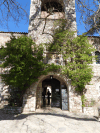

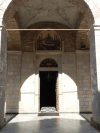

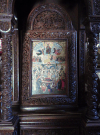
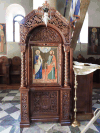
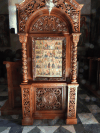





This page contains 16 pictures
Here are the links to the other main pages on Greece:
Page last updated on Fri Jul 8 18:43:44 2022 (Mountain Standard Time)
Kalavryta on soaring.geichhorn.com